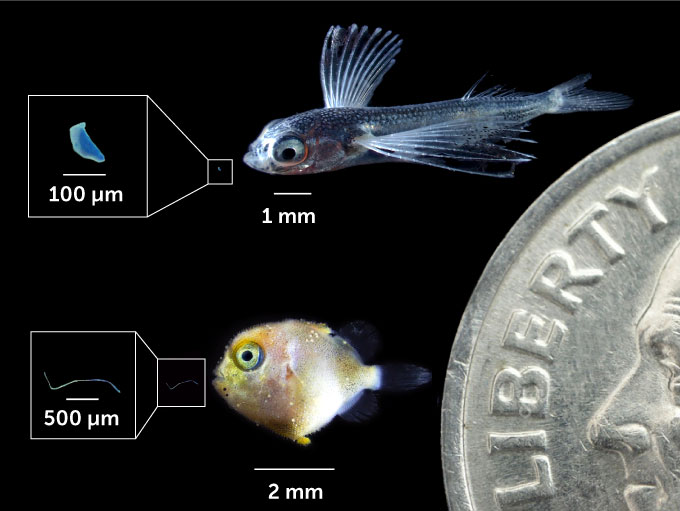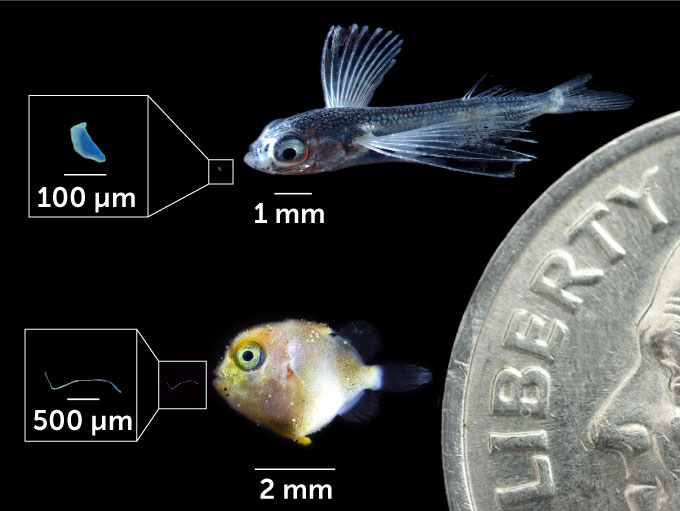Plastics can enter the food web at an unexpected point: larval fish as small as the tip of a pencil.
Larval fish congregate in ocean slicks — ribbons of calm water that form naturally on the ocean’s surface — to feast on an abundance of prey. Prey-sized plastics also accumulate in these fish nurseries, outnumbering the fish 7-to-1 and ending up in the stomachs of many, researchers report online November 11 in the Proceedings of the National Academy of Sciences.
“This is perhaps the most vulnerable life stage of pelagic fish,” says Anela Choy, a biological oceanographer at the Scripps Institution of Oceanography in La Jolla, Calif., who wasn’t involved in the study. She has documented plastic accumulation in the deep sea (SN: 6/6/19), and says this new study raises important questions about the effects of plastic ingestion at such a fragile life stage.
The researchers set out to study larval fish, not plastics, says Jonathan Whitney, a marine ecologist for the National Oceanic and Atmospheric Administration in Honolulu. After eggs hatch, tiny fish just a few millimeters in length spend their first days to weeks feeding and growing at the ocean surface before returning to their natural habitat. But “we know very little about where they go, what they eat, and how they find their way back home,” Whitney says.
Previous research has suggested that ocean slicks concentrate plankton and other nutrients, and might serve as tranquil nurseries for young fish, Whitney says. He and his colleagues decided to investigate ocean slicks just off the west coast of the island of Hawaii, where fish from a variety of ecosystems — open water, deeper sea and coral reefs — converge.
The researchers towed a specialized net inside and outside ocean slicks 100 times from 2016 to 2018 to sample larval fish diversity. But when the researchers inspected their hauls, they quickly realized their study wasn’t going to be just about fish.
After manually picking through the catch, the researchers counted over 11,000 larval fish, including blennies and goatfish from coral reefs, mahi mahi and swordfish from open waters, and anglerfish from depths barely touched by light. “It shows how briefly interconnected these vastly different ecosystems are,” says coauthor Gareth Williams, a marine biologist at Bangor University in Anglesey, Wales.
The nets snagged eight times as many fish in ocean slicks than in adjacent waters, confirming the slicks’ role as an early fish nursery. But inside these slicks, the tiny swimmers were outnumbered by plastic 7–1. “We were shocked,” Whitney says. “A five-minute tow in what looks like crystal clear water can turn up 10,000 pieces of plastic.”
 A larval fish (flying fish, top; triggerfish, bottom) collected in an ocean slick off the coast of Hawaii Island. In this composite, they’re situated near plastic fragments they had ingested. A dime is shown for scale.J. Whitney/NOAA Fisheries
A larval fish (flying fish, top; triggerfish, bottom) collected in an ocean slick off the coast of Hawaii Island. In this composite, they’re situated near plastic fragments they had ingested. A dime is shown for scale.J. Whitney/NOAA Fisheries A larval fish (flying fish, top; triggerfish, bottom) collected in an ocean slick off the coast of Hawaii Island. In this composite, they’re situated near plastic fragments they had ingested. A dime is shown for scale.J. Whitney/NOAA Fisheries
A larval fish (flying fish, top; triggerfish, bottom) collected in an ocean slick off the coast of Hawaii Island. In this composite, they’re situated near plastic fragments they had ingested. A dime is shown for scale.J. Whitney/NOAA FisheriesOf those fish large enough to be dissected, the researchers found that 8 percent had eaten prey-sized microplastics. “The vast majority of larval fish die before reaching adulthood,” so the poor diet comes at a time when the fish are already exceedingly vulnerable, Williams says.
Little is known about the consequences of larval fish ingesting plastic. But Jennifer Brandon, an oceanographer at Applied Ocean Sciences who is based in San Diego, says it can’t be good for them. Plastic ingestion by adult fish has been linked to liver toxicity, tumors, malnutrition, behavioral problems and death. Without a fully developed liver that can filter toxins, these effects could be even worse in larval fish.
She says the study may even have underestimated the abundance of plastics in slicks. “They used a net that may have missed smaller fragments of plastics, so it could be even worse.”
Larval fish play a big role in the ocean food web. Seabirds skim them off the water’s surface, while larger fish, such as tuna, eat them from below. If larval fish ate plastic, the predators that eat them could accumulate potentially harmful levels of plastic themselves, the researchers say. Humans also eat some of those fish when full grown, such as mahi mahi, and their predators.
To Whitney, the study underlines how insidious plastics are in the environment. “Finding plastics in these little guys was honestly kind of an emotional hit,” he says. “Climate change is a huge punch to ocean fish. Overfishing another punch. And now, at their most vulnerable stages, there’s yet another human induced impact.”
Source: Heart - www.sciencenews.org



